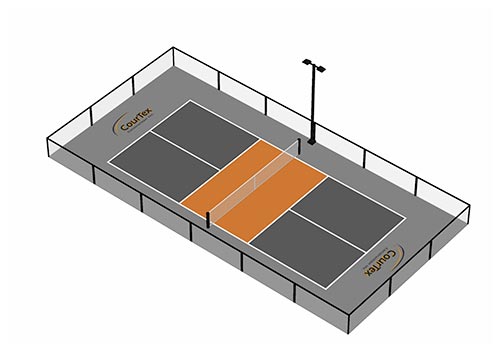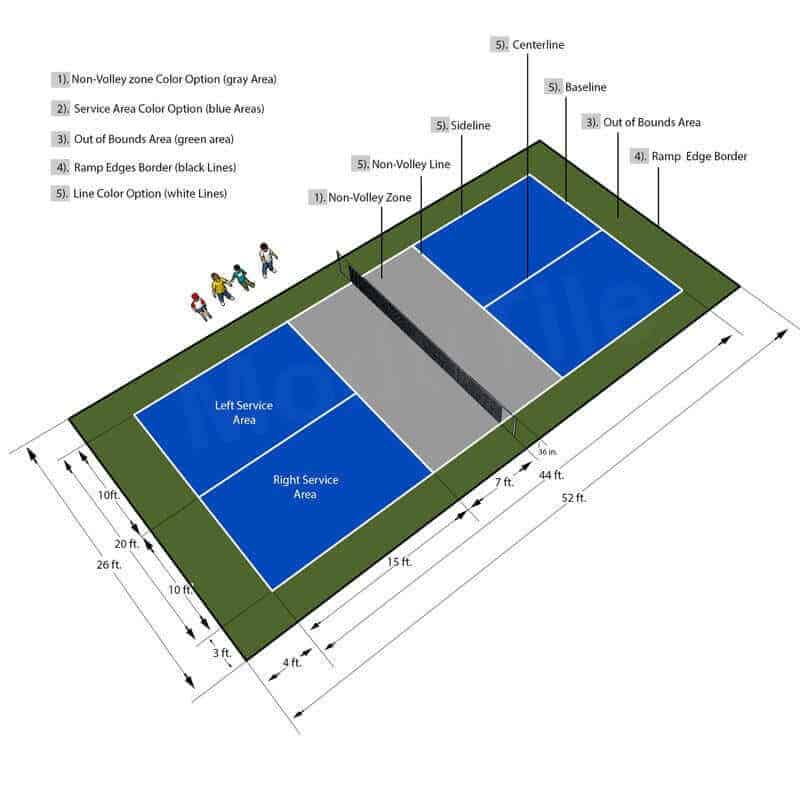Sustainable Practices in Pickleball Court Building And Construction You Need To Know
As the appeal of pickleball continues to rise, so too does the demand for lasting methods in court building. This strategy not just addresses environmental issues but likewise improves the durability and performance of the courts. From picking environmentally friendly materials to implementing reliable water drainage and energy-saving lights remedies, there are many techniques to take into consideration. The effect of these techniques expands far beyond the court itself. Comprehending exactly how each aspect adds to a more sustainable future welcomes better exploration right into the intricate equilibrium between entertainment growth and environmental stewardship.
Picking Eco-Friendly Products
Picking green products is a critical step in the building of lasting pickleball courts. The option of lasting products not only minimizes environmental effect but additionally boosts the durability and efficiency of the court. Key products consist of recycled rubber for the surface, which supplies exceptional sturdiness and shock absorption while drawing away waste from land fills.
In addition, utilizing locally sourced products reduces transport exhausts and supports local economies. Pickleball court construction. Making use of native woods for fence and seating can provide a lasting visual while guaranteeing resilience against the elements.
Incorporating absorptive products for court foundations can additionally add to sustainability by enabling natural water drainage and minimizing drainage. These options not only shield local communities but also advertise much healthier play atmospheres.
Effective Drain Solutions
While the selection of eco-friendly materials is necessary, carrying out efficient drain services is equally crucial for maintaining lasting pickleball courts. Correct water drainage not only protects the court surface area from water damages but additionally lessens erosion and overflow, promoting environmental stability.
Effective water drainage systems can include permeable paving, which permits water to infiltrate the ground instead of pooling on the surface area. This decreases the possibility of standing water, which can cause mold and mildew and various other maintenance problems. Furthermore, including purposefully placed drainage networks and swales can direct excess water away from the court location, making sure a completely dry having fun surface area and stopping dirt disintegration.
Utilizing native vegetation in the landscape design around the courts can better improve drain by absorbing excess water and decreasing overflow. These plants need less watering and promote biodiversity, aligning with sustainable techniques.
Furthermore, it is essential to regularly preserve the drain system to guarantee its long-term efficiency. This includes cleaning particles and monitoring for obstructions. By prioritizing efficient water drainage services, pickleball court erectors can considerably add to the sustainability and longevity of the facility, ultimately benefiting both players and the atmosphere.
Energy-Efficient Illumination Options
As the need for pickleball continues to expand, integrating energy-efficient lights alternatives right into court design has come to be progressively crucial for sustainability. Standard lights systems frequently take in too much power, adding to greater functional costs and environmental impact. As a result, taking on contemporary, energy-efficient technologies is crucial for both new building and constructions and remodellings.
LED (Light Emitting Diode) illumination stands out as a premier option because of its long life and energy savings (Pickleball court construction). Compared to traditional lights, LEDs utilize about 75% less energy and can last approximately 25 times much longer, considerably reducing maintenance expenses. The directional nature of LED lighting reduces light pollution, guaranteeing that lighting is focused on the court rather than bordering areas.

Lasting Surface Area Alternatives
Discovering lasting surface alternatives for pickleball courts has obtained grip among home builders and gamers alike. The focus on environment-friendly materials not just straightens with the growing ecological understanding yet also improves the performance and sturdiness of the courts.
One prominent alternative is making use of recycled rubber, which can be sourced from made use of tires. This material gives superb shock absorption, decreasing the risk of injuries for gamers while promoting sustainability. Furthermore, modular floor tiles made from recycled plastics provide an additional practical alternative. These ceramic tiles are easy to change and install, and their convenience enables various court arrangements.
Natural yard courts are likewise becoming a lasting choice, advertising biodiversity and reducing the heat island effect. However, they need normal upkeep and water, which might not straighten with all sustainability objectives.

Water Conservation Techniques

Another reliable technique includes the installment of rainwater harvesting systems. These systems collect and keep rain for use in keeping court surfaces and landscape design. This method not just conserves safe and clean water yet also lowers reliance on community resources.
Furthermore, using drought-resistant landscaping around the courts is crucial. Native plants need much less water and are much better adapted to regional climate conditions, therefore lowering overall water usage. Additionally, making use of efficient irrigation systems, such as drip irrigation, ensures that water is provided directly to plant roots, reducing evaporation and waste.
Final Thought
Including lasting practices in pickleball court building and construction considerably adds to environmental preservation and resource efficiency. Utilizing eco-friendly materials, implementing effective drainage services, and embracing energy-efficient illumination choices can considerably minimize environmental impact. Additionally, exploring sustainable surface area click for info choices and using water preservation methods enhance the total sustainability of these leisure facilities - Pickleball court construction. By focusing on these methods, the building and construction of pickleball courts can line up with broader ecological goals while promoting longevity and functionality within communities.
As the appeal of pickleball continues to increase, so also does the need for lasting methods in court building and construction.Picking environmentally friendly products is a crucial step in the building and construction of sustainable pickleball courts. By prioritizing energy-efficient lights options, pickleball court fitters can contribute to a much more lasting future while meeting the requirements of stakeholders and players alike.Integrating sustainable surface options not only enhances the efficiency of pickleball courts yet additionally paves the method for implementing efficient water preservation strategies.Including sustainable techniques in pickleball court construction dramatically adds to environmental conservation and source effectiveness.